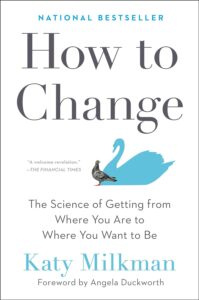What We’re Reading: “How to Change” by Katy Milkman
How to Change: The Science of Getting from Where You Are to Where You Want to Be by Katy Milkman
Research, lessons, and strategies to get from where you are to where you want to be
 For this newsletter’s edition of What We’re Reading, I was eager to read and embrace How to Change: The Science of Getting from Where You Are to Where You Want to Be by Katy Milkman. Professionally, as the new Executive Director of the Knott Foundation, this book seemed like the perfect complement to support the Foundation’s new strategic initiatives, and personally, I am always looking for ways that I can grow and better support others, while mastering positive change and habits.
For this newsletter’s edition of What We’re Reading, I was eager to read and embrace How to Change: The Science of Getting from Where You Are to Where You Want to Be by Katy Milkman. Professionally, as the new Executive Director of the Knott Foundation, this book seemed like the perfect complement to support the Foundation’s new strategic initiatives, and personally, I am always looking for ways that I can grow and better support others, while mastering positive change and habits.
In How to Change, behavioral scientist and award-winning Wharton Professor, Katy Milkman, explains why human nature frequently interferes with the best of intentions, and how adopting tailored, evidence-based strategies is the key to effecting lasting, positive behaviors.
In her book, Dr. Milkman shares six proven barriers to change including impulsivity, procrastination, forgetfulness, laziness, confidence, and conformity. However, she also shares key findings that support change and the creation of new positive habits including the importance of fresh starts, gamification, or adding game-like features in pursuit of a goal, public pledges of a goal commitment, the importance of timely reminders and checklists, tracking your behavior, and surrounding yourself with mentors who lift you up and have achieved similar goals.
As I reflected on her research and the findings in her book, I was able to identify some key takeaways to apply to my own life. As an avid runner, I must admit that my half-marathon training has not been as regular as I get older and especially in the colder weather. So, to develop a more positive habit in my running routine I am committing to apply the following recommendations from How to Change:
- Start fresh – the anticipation of Easter and spring is the perfect time to jump-start activities outside, so I committed to run a late spring half-marathon.
- Surround myself with other goal-oriented runners – I have stepped out of my comfort zone and just completed a running nutrition course with other runners.
- Track my mileage – I used to keep a chart of my daily runs and have started recording this data again as an affirmation of my successes.
- Make it fun – for the first time in over 15 years of completing half-marathons, I chose an out-of-town location for the late spring run and invited my husband to join me for the weekend.
These recommendations may seem simple, but according to Dr. Milkman, only 20 percent of the goals set each January succeed, because change and new habits take time. When you use the tools in her book to overcome whatever internal obstacles you face on your journey to change, she suggests that you will want to use them permanently. So, although my take-homes are simple, I am looking forward to restoring the joy that comes from these changes and adopting Dr. Milkman’s blueprint for creating new positive habits.
